Least Village Has Its Blacksmith
The next section of Chapter 3 of Stewart Brand’s Maintenance on Books in Progress
In the next section of Chapter 3, Communities of Practice, Steward Brand writes about history’s great stewards of maintenance: blacksmiths. Stewart writes:
For millennia, it was the greatest show in town. The distant rhythmic clanging of metal on metal was an invitation to draw near. Up close, you saw magic. Hard metal was made soft and then hard again in a useful new shape through controlled violence—intense heat, hammer blows, sparks flying, and explosive quenching in water. It was like a reverse volcano that turned chaos into order and utility.
All of it was in the charge of one man moving calmly from forge to anvil with white-hot metal, pounding it red, creating horseshoes, knives, hoes, nails, pots, hinges, and locks—and repairing them when they became worn or broken. Crafting metal was so essential that every town had to have at least one blacksmith, and many saw him as the very embodiment of virility. No wonder the commonest family name in some societies is Smith.
Read the whole piece, and add your own comments, corrections and thoughts, here.
Stewart would love to know:
What is factually wrong in this piece (and what would be right)
What sounds wrong—has the wrong tone or language or associations (and what would be right)
What delights you (if anything)
What details would be good to add?
To submit a comment, select some text. Hit the "Make Comments" button on the right-hand margin. Log in with your email (it responds instantly in your email and is good for two weeks). Write your comment in the box that appears. And be sure to hit SUBMIT.
Stewart replies to every comment within 24 hours. When he does, an email will go to you alerting you of the reply, and you're welcome to comment further. And you can reply to anyone else's comments or replies.





This is a most enjoyable read! I'm pleased there's a mention of African blacksmiths - this is an extraordinarily neglected area of study as West Africans in Nigeria and elsewhere mastered sophisticated ironworking as early as 1500 BCE. Blacksmiths in Africa play a complex role in society (as they do in nearly every other society too). They were/are cultural heroes, spiritual intermediaries and custodians of knowledge. Like blacksmiths elsewhere too, they are feared and sometimes stigmatised. In many cultures blacksmiths are seen as figures of power, potent and mysterious yet highly valuable as holders of 'secret knowledge': the ability to transform stone into tools and weapons seems, still to be deeply magical. This is the very core of their trade "mystery" - a medieval word for guilds. Yet because the village smithy was a place of , noise, darkness, smoke and fumes, they were often isolated to the fringes of communities. It might be interesting to consider the historical role of India as probably the world's first truly sophisticated ironworkers. There's an ornate 5 metre rust resistant iron pillar in Delhi made around the year 400 CE which still flabbergasts historians of technology. The ancient Romans used Indian iron to make armour and cutlery. Indian Wootz steel was regarded as the best steel in the world and the Damascus pattern steel technique - much loved by current blacksmiths - was almost certainly Indian in origin. I hope my remarks don't throw any shade on this fine project - I look forward to seeing it in print - kind regards Mark Thomson (Australian buyer of the Whole Earth Catalog in 1970!)